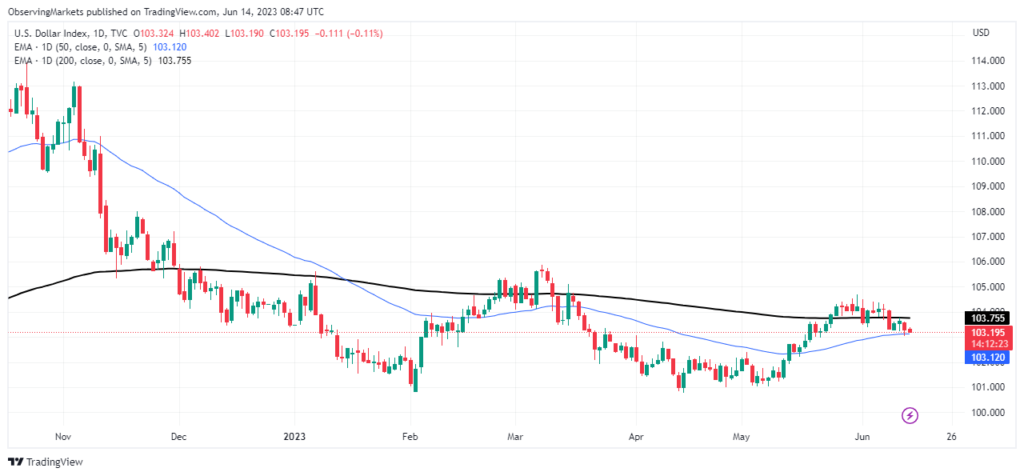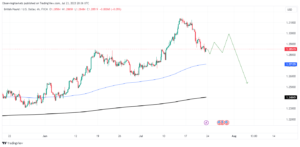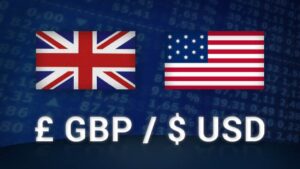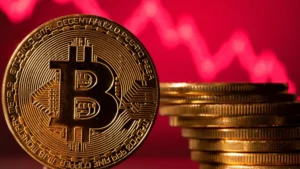Markets have taken a cautious stance in the middle of the week as investors prepare for the Federal Reserve’s (Fed) monetary policy decision announcements. The Fed will also release the revised Summary of Economic Projections, or dot plot, and FOMC Chairman Jerome Powell will hold a press conference to address the policy outlook.
The Consumer Price Index (CPI) in the United States fell to 4% year on year in May, down from 4.9% in April, according to the US Bureau of Labor Statistics (BLS) on Tuesday. The Core CPI, which excludes volatile food and energy costs, fell to 5.3% in the same period, as expected, from 5.5%. Following the inflation report, the CME Group FedWatch Tool’s chance of a 25 basis point Fed rate hike slipped below 10%.

The US Dollar Index consolidates its losses from Tuesday below 103.50, as US stock index futures trade neutral. Meanwhile, the 10-year US Treasury bond rate hovers around 3.8%.
On Tuesday, the EUR/USD reached its highest level in nearly a month at 1.0825 before entering a consolidation period at around 1.0800 on Wednesday.
GBP/USD gained significantly on Tuesday and continued to rise early Wednesday. The price of the pair was last seen trading above 1.2600.
On Tuesday, the USD/JPY closed in positive territory for the third consecutive trading day, but lost its bullish momentum after touching 140.00.
The gold price rose to $1,970 in response to disappointing US inflation figures on Tuesday, but then reversed course due to a dramatic rally in US Treasury bond yields in the late American session. In the European session on Wednesday, XAU/USD clings to minor recovery gains at approximately $1,950.
Here are the expectations as forecast by analysts and researchers of nine major banks.
Danske Bank
We expect the Fed to maintain rates unchanged. Focus will be on communication around potential hike in July & the updated dots. The Fed is unlikely to close the door for hikes, but we doubt they will materialize.
TDS
We maintain our long-held view that the Fed will tighten rates by a final 25 bps in June to a range of 5.25%-5.50%. If the Fed decides to ‘skip’ the June meeting, we expect the decision to be accompanied by communication that leans hawkish, signaling a likely hike for July. While a surprise Fed hike might provide some immediate knee-jerk support for the USD, the fact that it is likely the Fed’s last hike should reinforce that we’re nearing the end of the tactical rally.
Nordea
A pause is likely for the FOMC to digest economic data. Chairman Powell will likely stress at the press conference that the Fed is data-dependent but that it also has a hiking bias. We believe the Fed will raise the Fed funds rate at least one more time this year.
Rabobank
Given Powell’s bias toward a pause in June, we expect the FOMC to keep the target range for the federal funds rate unchanged this month. However, we expect the FOMC to leave the door to a July rate hike wide open to convince the hawks to skip June. Because of the reacceleration of the economy, and the modest impact of the banking turmoil on credit conditions, we now expect the FOMC to resume the hiking cycle in July in order to get inflation under control. For now, we expect one rate hike of 25 bps before the FOMC takes a pause for the remainder of the year.
RBC Economics
The Fed looks likely to pass on raising interest rates – though policymakers are talking about a ‘skip’ rather than a pause. The US unemployment rate ticked higher in May, and job openings have continued to fall. But labour markets are still exceptionally tight and have been more resilient than expected despite higher interest rates. Still, it takes time for tighter monetary policy to impact the economy and there are signs that inflation pressures are easing, even if it’s happening more slowly than policymakers would like.
Deutsche Bank
We expect the Fed to hold but raise rates in July. We expect the meeting statement, Summary of Economic Projections (SEP), dot plots, and Chair Powell’s press conference to skew hawkish, signalling the likely need for further policy tightening as soon as the July 26 meeting.
Wells Fargo
We see the most likely outcome for this week’s meeting as the FOMC making no change to its policy rate but making clear that another hike at its July 26 meeting remains a distinct possibility. If the Committee does decide to leave the fed funds rate unchanged, we would expect the statement to emphasize the significant amount of policy tightening undertaken in a little over a year and to keep the door open to potentially more tightening. The clearest indication that FOMC participants believe some further tightening is more likely than not probably will come from the Summary of Economic Projections (SEP). We think the median ‘dot’ for year-end 2023 will shift up by 25 bps relative to the March SEP. If so, then most FOMC members would be indicating that the target range for the federal funds rate needs to go at least 25 bps higher from its current setting of 5.00%-5.25%. We think the median dots for 2024 and 2025 will also rise by 25 bps each to reflect a similar pace of eventual policy easing as was the case in the March projections.
Credit Suisse
The FOMC appears likely to ‘skip’ hiking the Fed Funds rate at its June 14 meeting, but still signal that further hikes remain possible if not likely at subsequent meetings. The hawks probably need higher-than-expected CPI data on June 13 to shift the vote in favor of a June hike. If the FOMC does pause this month, we see a meaningful chance it will hike 25 bps in July.
ANZ
The resilience of recent activity data and ongoing sticky inflation suggest the FOMC should consider raising the fed funds rate (FFR) by 25 bps to 5.50%. However, based on recent Fed communication we think the central bank is leaning toward skipping a rate hike at this meeting and potentially tightening more later. We expect the FOMC to upgrade its GDP and inflation forecasts for 2023, and thus a higher terminal rate view is a possibility. The resilience of recent activity data has resulted in us upgrading our 2023 GDP forecast by 0.2ppt to 1.5%. We maintain our terminal FFR view of 5.50% and continue to see risks to the upside. We now expect peak rates to hold to mid-2024 from Q1 previously.




